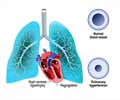Implantable soft robotic devices to enhance cardiac function in left or right heart failure have been developed by a research team at Boston Children’s Hospital
- Implantable robotic devices may offer new therapy for heart failure.
- These devices help recover blood flow and pressure.
- These devices also have artificial muscles to perform motions.
The heart of the challenge - pumping blood efficiently
Although other existing mechanical pumps can help propel blood through the heart, they are designed so that blood must run through the pump itself, exposing blood to its unnatural surface.
"Running blood through a pump always requires a patient to be placed, permanently, on anticoagulant medication to prevent blood clotting," Vasilyev says, who is a co-senior author on the paper. "It can be very difficult to keep the right balance of medication, especially in pediatric patients, who are therefore at risk of excessive bleeding or dangerous clotting."
So, using external actuators to help squeeze blood through the heart's own chamber, the team has designed a system that could theoretically work with minimal use of anticoagulants.
"We've combined rigid bracing with soft robotic actuators to gently but sturdily help a diseased heart chamber pump blood effectively," Vasilyev says.
"With the use of classic left ventricular assist devices, there are patients who experience a septum shift towards the right side and subsequent ballooning of the right ventricle, which can cause secondary right heart failure," Vasilyev says. "Here, the rigid brace keeps the septum in its original position, protecting the healthy right side of the heart from the mechanical load of the left ventricular assistance."
Tailoring the concept for future translation
Altogether, the system involves a septal anchor, a bracing bar and sealing sleeve that pass through the ventricle wall, and a frame embedded with soft actuators that is mounted around the ventricle. The researchers designed two distinct versions of the system for the right and left ventricle.
In animal studies, the soft robotic system contributed significantly to the diseased ventricle's ability to eject blood. The researchers speculate that the system's effectiveness is due in part to its integration with the septum, which plays a key role in the heart's ability to pump blood.
The system also made significant improvement in its ability to draw blood into the ventricles, which is just as important as the heart's ability to pump it out.
"As the actuators relax, specially-designed elastic bands help return the heart's wall to its original position, filling the chamber sufficiently with blood," Vasilyev says.
Based on these initial proof-of-concept results, Vasilyev and his team are working on key design modifications that can bring this system closer to use in humans, such as portability and miniaturization of the components. They also need to do longer tests in animals to see how the system impacts the heart over prolonged periods of time.
References:
- Christopher J. Payne, Isaac Wamala et al. Soft Robotic Ventricular Assist Device with Septal Bracing for Therapy of Heart Failure, Science RoboticsDOI: 10.1126/scirobotics.aan6736
Source-Eurekalert
















